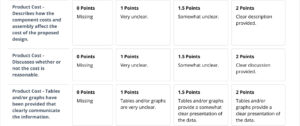Costs of Parts
- Type of paperResearch Paper
- SubjectDesign Analysis
- Number of pages1
- Format of citationAPA
- Number of cited resources4
- Type of serviceRewriting
Instructions will be uploaded later.

Robot Design Cost Analyses
Design analyses provide the criteria explored in the generation of cost-effective assembly orders for complex products and its components, in this case, robot cost and its components. According to the analyses, with regard to its proposal to optimal solutions in the assembly time minimization, suggests that the components for robot design will not cost much, thus prompting a great profit. The reason for this fact emanates from the fact that most of these components, which are the body parts, will be 3-D printed, leaving out the electrical parts and the main part to be used in control aspect of the robot. Besides, a cost-effective material called PRO Series PLA (Polylactic Acid) will be used to offer the 3-D printed parts. According to Drumright, Gruber & Henton (2000), the material is well renowned for its effectiveness in cosmetic prints, prototypes, desk toys, and low-stress applications.
In outlining the cost estimations of the components, it is realized that the PLA material will cost less than $16, (“PRO Series PLA Sampler Pack – 3.00mm | MatterHackers”, 2018), the range sensor component would cost $11.82 while motion sensor will cost $3.37, according to (“Robot Sensors – RobotShop”, 2018). Other components include its wheels that would cost $13.17 (“Robot Sensors – RobotShop”, 2018), its motors that would cost $5.84 dollars and connecting wires from Amazon costing $8.99. The total cost for the robot product and its parts would cost $66.17. As suggested by Wright & Monk (1991), benefits of a product may be accrued when the product’s configuration system is incorporated into the product platform and cost estimation rather than purchase. This in response would, therefore, suggest that the cost is reasonable since the product’s components are intensely affordable compared to buying a pre-built robot that may cost over a $100 dollars, perhaps with unexpected objectives.
The graph details the components cost allocation as described in Figure 1 below.
Figure 1: Robot parts cost estimations.
References
Amazon.com. (2018). Retrieved 14 March 2018, from https://www.amazon.com/MOTOR- MICRO-METAL-GEAR- 30/dp/B00G3IK1P2/ref=sr_1_cc_1?s=aps&ie=UTF8&qid=1520990564&sr=1-1- catcorr&keywords=30%3A1+MICRO+METAL+GEAR+MOTOR+STALL
Drumright, R. E., Gruber, P. R., & Henton, D. E. (2000). Polylactic acid technology. Advanced materials, 12(23), 1841-1846.
PRO Series PLA Sampler Pack – 3.00mm | MatterHackers. (2018). MatterHackers. (2018). Retrieved 14 March from https://www.matterhackers.com/store/l/pro-series-pla-sampler- pack-3mm/sk/MLJ0YX6K
Robot Sensors – RobotShop. (2018). Robotshop.com. Retrieved 14 March 2018, from https://www.robotshop.com/ca/en/sensors.html
Wright, P. C., & Monk, A. F. (1991). A cost-effective evaluation method for use by designers. International Journal of Man-Machine Studies, 35(6), 891-912.

